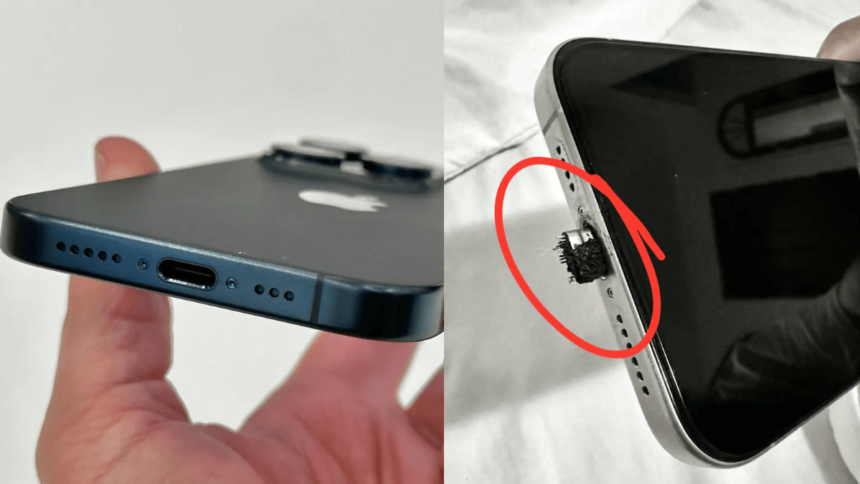The recent incidents involving the iPhone 15 Pro Max charger melt down have sent shockwaves through the Apple community and beyond. Several users have reported their devices overheating, with some even experiencing melting chargers and physical injuries. These alarming events bring to light the critical importance of using authentic accessories and the potential dangers of disregarding manufacturers’ warnings.
The Perilous Incident: A Reddit User’s Nightmare
A Reddit user, known as NoisilyMarvellous, brought the issue to the public’s attention when they posted about their harrowing experience with a non-Apple charger. According to their account, after a month of using their iPhone 15 Pro Max, the device became excessively hot while charging overnight.
The heat was so intense that it resulted in a burn mark on the user’s finger and caused the charger to melt, leaving burn marks on the phone and causing the metal part of the USB-C port to become stuck inside the device. This incident was not isolated, as similar reports surfaced from other users experiencing overheating issues, particularly when using third-party chargers and cables.
Charging cable got so hot it MELTED the plastic, broke into my phone and burned my finger. What can I do?
byu/NoisilyMarvellous iniphone The Underlying Problem: Non-Authentic Accessories
Investigations into these incidents reveal a common denominator: the use of non-authentic or generic USB-C chargers and cables. While Apple has long warned against the use of unlicensed accessories citing risks of overheating and fire hazards, many consumers opt for cheaper alternatives, often overlooking the potential consequences. In the case of the iPhone 15 Pro Max incidents, it was found that the affected individuals had used generic cables and chargers, which were not equipped to handle the device’s power requirements and safety protocols.
TechNave reported on the specifics of one such incident, emphasizing how the use of a generic USB-C cable led to the charger melting and the phone’s charging port being severely damaged. Gizmochina also highlighted the risks associated with using cheap, non-certified products, noting that such accessories might compromise not only the device’s functionality but also the user’s safety.
Apple’s Stance and Solutions
In response to the overheating issues, Apple has consistently emphasized the importance of using certified accessories. The A17 Pro chip in the iPhone 15 Pro Max is a powerful component, and while it offers enhanced performance and efficiency, it also requires proper handling and compatible accessories to ensure safe operation. Apple provides a list of certified products and partners, urging users to invest in these to avoid potential hazards.
Moreover, after widespread reports of overheating, Apple released an iOS update (17.0.3) aimed at addressing these concerns. ZDNET conducted tests post-update and confirmed a noticeable decrease in device temperature during fast charging, suggesting that the software might have played a role in managing the hardware’s heat generation.
Lessons Learned and Moving Forward
The incidents surrounding the iPhone 15 Pro Max charger meltdown serve as a stark reminder of the risks associated with using non-authentic accessories. Consumers are urged to consider the long-term safety and performance implications when purchasing accessories for their devices. As for manufacturers, there’s a growing demand for clearer guidelines and more accessible certified options to prevent such hazardous situations.
Apple, while providing solutions and updates, also faces the ongoing challenge of ensuring its devices can safely accommodate third-party accessories, a demand that’s unlikely to fade given the diverse market for phone accessories.
In conclusion, the iPhone 15 Pro Max charger meltdown incidents highlight a critical juncture in consumer electronics where safety, technology, and consumer behavior intersect. It’s a wake-up call for users and manufacturers alike to prioritize safety and authenticity in an ever-evolving digital landscape.



